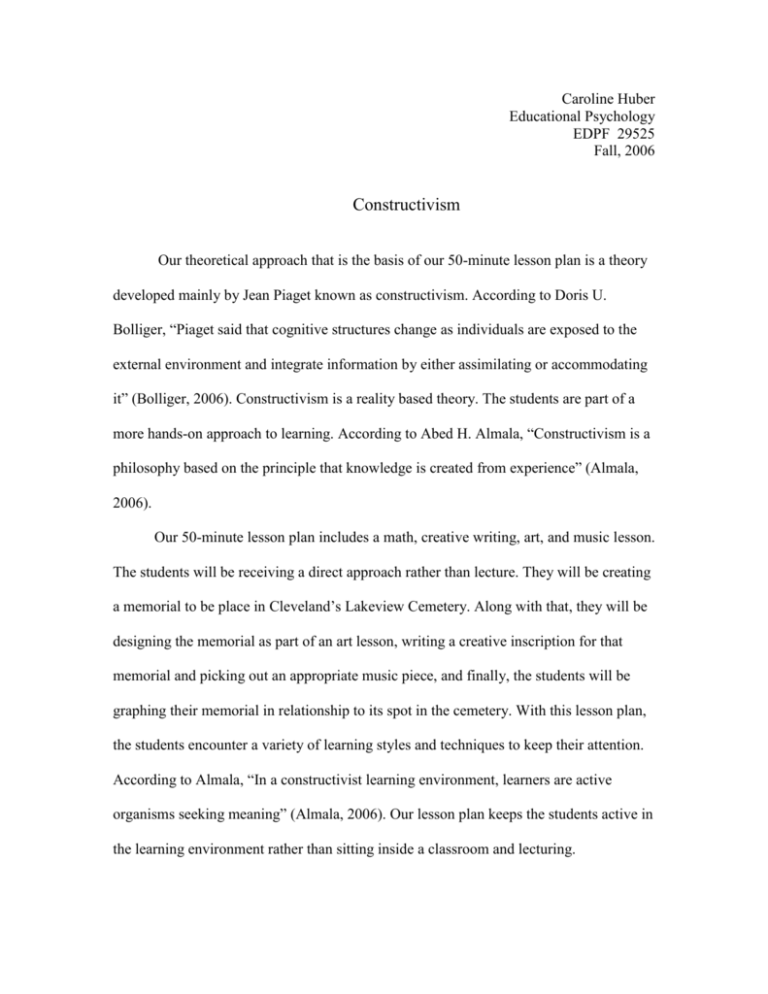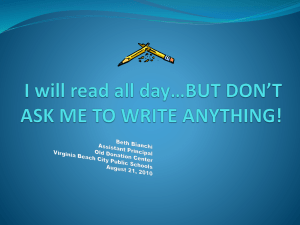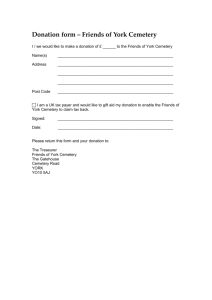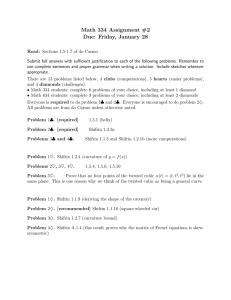Our theoretical approach that is the basis of our 50
advertisement

Caroline Huber Educational Psychology EDPF 29525 Fall, 2006 Constructivism Our theoretical approach that is the basis of our 50-minute lesson plan is a theory developed mainly by Jean Piaget known as constructivism. According to Doris U. Bolliger, “Piaget said that cognitive structures change as individuals are exposed to the external environment and integrate information by either assimilating or accommodating it” (Bolliger, 2006). Constructivism is a reality based theory. The students are part of a more hands-on approach to learning. According to Abed H. Almala, “Constructivism is a philosophy based on the principle that knowledge is created from experience” (Almala, 2006). Our 50-minute lesson plan includes a math, creative writing, art, and music lesson. The students will be receiving a direct approach rather than lecture. They will be creating a memorial to be place in Cleveland’s Lakeview Cemetery. Along with that, they will be designing the memorial as part of an art lesson, writing a creative inscription for that memorial and picking out an appropriate music piece, and finally, the students will be graphing their memorial in relationship to its spot in the cemetery. With this lesson plan, the students encounter a variety of learning styles and techniques to keep their attention. According to Almala, “In a constructivist learning environment, learners are active organisms seeking meaning” (Almala, 2006). Our lesson plan keeps the students active in the learning environment rather than sitting inside a classroom and lecturing. Futhermore, Almala mentions that, “The learning process in the constructivist environment is focused on enabling students to use knowledge in many different settings to make the learning itself as real as possible” (Almala, 2006). That is exactly our plan with our lesson. We are allowing the students to work with many different media and in various settings in order for each student to get the full learning experience. The idea behind our lesson is for each individual’s diverse learning needs to be met by using different subject areas and including several teaching styles. Bibliography Almala, A. (2006). Applying the Principles of Constructivism to a Quality E-Learning Environment. Distance Learning. 3, 33-40. Retrieved October 3, 2006, from the Educational Research Complete database. Bolliger, D. (2006). Creating Constructivist Learning Environments. Educational Media & Technology Yearbook. 31, 119-126. Retrieved October 3, 2006, from the Educational Research Complete database. Caroline Huber Educational Psychology EDPF 29525 Fall, 2006 Dysgraphia According to the literature, “Handwriting and drawing are complex behaviors in which linguistic, psychomotor, and biomechanical processes closely interact with maturational, developmental, and learning processes (Van Galen and Smits-Engelsman, 1997).” Children identified with the learning disability known as dysgraphia have a difficult time developing their writing skills. Hand-writing requires extended time for a high level of proficiency to develop (Van Galen and Smits-Engelsman, 1997). Students who experience dysgraphia have difficulty producing consistent and legible script. They do not experience problems commonly associated with dyslexia, a reading disability. These handwriting problems are typical of a physical nature and usually not connected to spelling or psycholinguistic problems (Van Galen and Smits-Engelsman, 1997). Dysgraphia is strictly a writing disability where students experience difficulty in automatically remembering and mastering the sequence of muscle motor movements needed in writing letters and numbers (Wagmeister and Shifrin, 2000). There are a few ways teachers can accommodate students in their classroom who have been identified with dysgraphia. For example, Westmark School in California has used recent advances in technology to instruct students who experience dysgraphia (Wagmeister and Shifrin, 2000). They used assessments that allowed for teachers and students to determine their learning styles and they also made sure to provide a rich and productive learning environment (Wagmeister and Shifrin, 2000). By doing so, the students could motivate and help each other to learn. Also, considering that dysgraphia is a writing disability, the use of computers can be extremely helpful. Even specific programs have been designed to accommodate dysgraphic students. Additionally, by using multiple and diverse learning approaches, each student can be assisted. And, finally, a safe and trustworthy learning environment where students can feel secure should be offered. Students need to be able to feel enough in order to take learning risks (Wagmeister and Shifrin, 2000). So, by assessing each individual student’s learning style and accommodating those different styles, students with dysgraphia should not feel left behind. Bibliography Smits-Engelsman, Bouwien C.M., & Van Galen, Gerard P. (1997). Dysgraphia in children: Lasting psychomotor deficiency or transient developmental delay? Journal of Experimental Child Psychology. 67, 164-185. Retrieved October 3, 2006, from the Academic Search Premier database. Wagmeister, Jane, & Shifrin, Ben. (2000). Thinking Differently. Learning Differently. Educational Leadership. 58, 45-48. Retrieved October 3, 2006, from the Academic Search Premier database. Caroline Huber Michael England John Pasternak Chris Guerrieri Visit to Cleveland’s Lake View Cemetery Upon arrival at the cemetery, the layout caused the visitors to engage physically and emotionally with the architecture and statuary. We first visited the Wade Chapel where we met with Wayne Bifano. The chapel is listed on the National Register of Historic Places and was built in honor of Jeptha Wade, founder of the Western Union Telegraph Company and the first president of Lake View Cemetery Association. Wayne gave us a brief tour and history of the chapel before we headed to the Garfield Monument. Dedicated to our 20th President, the Garfield Monument contains caskets of the President and his wife. After touring the monument, we moved onto the Lake View Cemetery Dam. This is the largest concrete-poured dam east of the Mississippi and can hold 80M gallons of storm water. Currently, the dam is holding no water. Visiting the cemetery gave us the inspiration to witness how death can inspire so many different facets of our life. Chris Guerrieri Caroline Huber Michael England John Pasternak MATH Measurement Standard Students estimate and measure to a required degree of accuracy and precision by selecting and using appropriate units, tools and technologies. Grade 9 Benchmark D. Use proportional reasoning and apply indirect measurement techniques, including right triangle trigonometry and properties of similar triangles, to solve problems involving measurements and rates. 4. Use scale drawings and right triangle trigonometry to solve problems that include unknown distances and angle measures. Grade 10 Benchmark D. Use proportional reasoning and apply indirect measurement techniques, including right triangle trigonometry and properties of similar triangles, to solve problems involving measurements and rates. 1. Explain how a small error in measurement may lead to a large error in calculated results. For the first standard, it is very important for students to learn this goal because they will need to know how to apply proportions and ratios not only for their later coursework but for everyday life scenarios. For example students can use proportions for reading maps and other objects that are made to scale. For the second standard I believe that it is very important. This standard will demonstrate to students exactly how important making sure your answer is correct. It is also important to demonstrate to students that in Mathematics even the slightest mistake can cause a larger error in your results. Language Arts Writing Process Standard Students’ writing develops when they regularly engage in the major phases of the writing process. The writing process includes the phases of prewriting, drafting, revising and editing and publishing. They learn to plan their writing for different purposes and audiences. They learn to apply their writing skills in increasingly sophisticated ways to create and produce compositions that reflect effective word and grammatical choices. Students develop revision strategies to improve the content, organization and language of their writing. Students also develop editing skills to improve writing conventions. Benchmark A: Formulate writing ideas and identify a topic appropriate to the purpose and audience 4. Determine a purpose and audience and plan strategies (e.g., adapting focus, content structure and point of view) to address purpose and audience. Benchmark B: Use revision strategies to improve the style, variety of sentence structure, clarity of the controlling idea, logic, effectiveness of word choice and transitions between paragraphs, passages or ideas. 9. Use precise language, action verbs, sensory details, colorful modifiers and style as appropriate to audience and purpose. By the end of grades 8-10, students should be able to formulate writing ideas and identify appropriate topics while also being able to revise and improve their writing, use a variety of sentence structures and word choices, and effectively include transitions in their writing. These skills are necessary for students to be able to advance into more enhanced writing classes. These abilities are essential for children to develop cognitively and also emotionally. Creative writing can open a student’s mind to new opinions and emotions while also allowing student’s to express their feelings and get to know themselves better. As a student enters high school, it’s crucial for them to know who they are and how to express themselves. Fine Arts Standards Art Historical, Cultural and Social Contexts Students understand the impact of visual art on the history, culture and society from which it emanates. They understand the cultural, social and political forces that, in turn, shape visual art communication and expression. Students identify the significant contributions of visual artists to cultural heritage. They analyze the historical, cultural, social and political contexts that influence the function and role of visual art in the lives of people. Grade Nine Benchmark A: Explain how and why visual art forms develop in the contexts (e.g., cultural, social, historical and political) in which they were made. 1. Discuss the roles of visual art forms within social contexts. Grade Ten Benchmark B: Compare works of art to one another in terms of the historical, cultural, social and political influences evident in the works. 3. Explain the circumstances and events that influence artists to create monuments and site-specific works. It is important for students at this age to be working on figuring out arts placement in the real world. By allowing students to discover how art’s role in society takes many forms, a teacher can begin early on to discuss the contextual issues which make art work more personal and relative to its surroundings. Students at this age also need to develop their critical thinking skills in order for them to better understand the many diverse activities and traditions which take place around them everyday. Understanding self expression in regards to personal ideas and feelings allows students to grow emotionally by giving them alternative and powerful outlets for communication. Additionally at this point in development, students should have a firm grasp on motor skills, and are able to successfully create what they put their minds to and plan out. By combining art as a practical display of knowledge retention from interdisciplinary connections, not only will the math and art programs be strengthened, but the students will have a better likelihood of retaining the information. Music Creative Expression and Communication Students sing, play instruments, improvise, compose, read, and note take music. Grade 9 Benchmark B: Read, perform or compose music repertoire using a variety of tonalities while demonstrating an understanding of the language of music. 8. Read, perform and/or notate a one-octave chromatic scale, ascending and descending. Grade 10 Benchmark B: Read, perform or compose music repertoire using a variety of tonalities while demonstrating an understanding of the language of music. 10. Identify articulations, expressive symbols and terms. Caroline Huber John Pasternak Creative Expression and Communication Students sing, play instruments, improvise, compose, read and notate music. Benchmark B: Read, perform or compose music repertoire using a variety of tonalities while demonstrating an understanding of the language of music. 8. Read, perform and/or notate a one-octave chromatic scale, ascending and descending. 10. Identify articulations, expressive symbols and terms The music portion of our Unit Plan will consist of teaching the students techniques in recognizing symbols and terms. They will also learn how to analyze pieces of music to correspond with our Unit Lesson Plan of constructing a memorial in Cleveland’s Lake View Cemetery. This will fulfill the Ohio Department of Education’s Fine Arts Standard under Creative Expression and Communication. English Language Arts Writing Processes Students’ writing develops when they regularly engage in the major phases of the writing process. The writing process includes the phases of prewriting, drafting, revising and editing and publishing. They learn to plan their writing for different purposes and audiences. They learn to apply their writing skills in increasingly sophisticated ways to create and produce compositions that reflect effective word and grammatical choices. Students develop revision strategies to improve the content, organization and language of their writing. Students also develop editing skills to improve writing conventions. Benchmark B: Develop audience and purpose for self-selected and assigned writing tasks. 4. Determine a purpose and audience and plan strategies (e.g., adapting focus, content structure and point of view) to address purpose and audience. Benchmark D: Use revision strategies and resources to improve ideas and content, organization, word choice and detail. 9. Use precise language, action verbs, sensory details, colorful modifiers and style as appropriate to audience and purpose. The writing process of our Unit Plan will consist of students inscribing a creative narrative to be placed on a plaque for the monument. They will first identify their audience and address their purpose. After completing the writing assignment, students should be able to revise their own papers as well as their peers. They need to include a variety of sensory vocabulary and sentence structure. This activity will meet the English Language Arts Writing Processes standard of the Ohio Department of Education lesson template.









